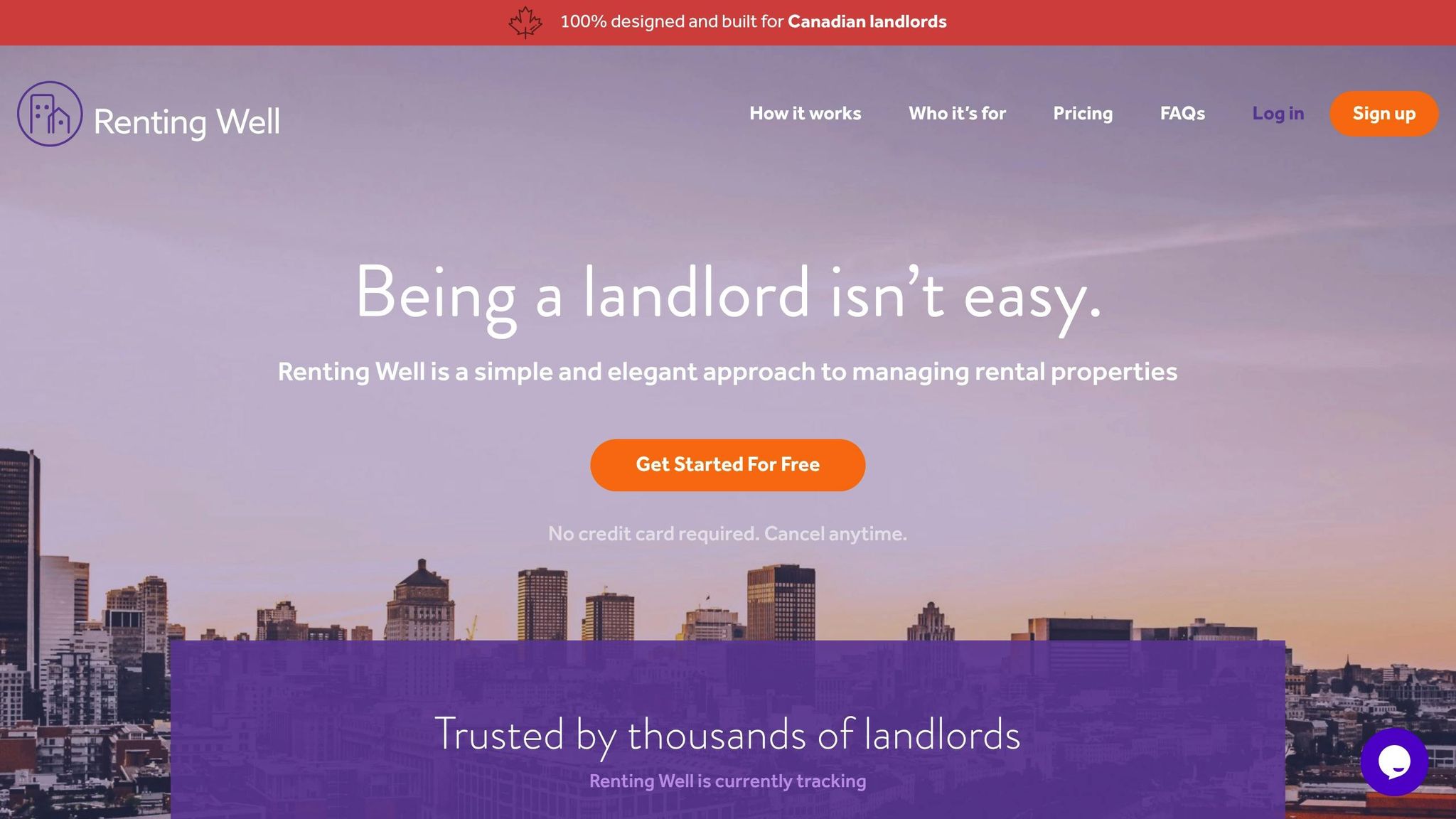Want to protect your rental property and keep tenants happy? Regular maintenance is the key. Here’s a quick summary:
- Why it matters: Prevent costly repairs, retain tenants, and maintain property value.
- Cost: Allocate 1–4% of your property’s value annually for maintenance.
- Seasonal focus:
- Spring: Inspect the exterior, clean gutters, prep HVAC, and manage landscaping.
- Summer: Check AC systems, control pests, maintain windows, and inspect outdoor areas.
- Fall: Clean gutters, prep heating systems, and winterize plumbing.
- Winter: Manage snow/ice, prevent frozen pipes, and test safety devices.
Pro tip: Keep detailed records, budget for maintenance, and communicate clearly with tenants. These steps will save you time and money while improving tenant satisfaction.
21 Commonly Forgotten Maintenance Tasks For Rental …
Spring Tasks
Spring is the perfect time to get your property back in shape after winter’s wear and tear.
Check Building Exterior
Start by inspecting your roof. Use a hose to spot leaks, missing shingles, or damaged flashing. Examine foundation walls for cracks caused by freeze-thaw cycles, and look for any warping or damage on the siding.
Pay attention to windows and doors. Ensure caulking is intact to keep water out and help with energy efficiency.
Finally, make sure water is draining properly and not pooling around your property.
Clear Drainage Systems
"Left unaddressed, these are expensive and laborious building repairs – ones that could have been avoided by an annual spring gutter cleaning."
Key tasks for drainage include:
- Clearing debris from gutters and downspouts to ensure water flows away from the foundation.
- Checking for standing water after rain, which could signal drainage issues.
- Considering gutter guards to cut down on future cleaning needs.
HVAC Spring Maintenance
Get your HVAC system ready for the warmer months by:
- Cleaning or replacing air filters.
- Inspecting and cleaning outdoor condenser units.
- Checking ductwork for leaks and sealing any gaps.
- Testing the cooling system to ensure it’s running efficiently.
Spring Yard Work
- Tree Management: Trim branches that are too close to the roof or building.
- Drainage: Clear out landscape drainage systems to prevent water buildup.
- Lawn Care: Start mowing regularly and repair any damage caused by winter.
- Safety Checks: Inspect outdoor lighting and walkways for any issues left behind by winter weather.
Summer Tasks
Summer can be tough on rental properties, with higher AC usage and more outdoor activities putting systems and spaces to the test.
AC System Check
As temperatures climb, keeping the AC running smoothly is crucial. A well-maintained system not only keeps tenants comfortable but also helps manage energy costs.
- Professional HVAC Inspection
Hire a licensed HVAC technician to perform a thorough inspection. This includes checking refrigerant levels, cleaning the condensation line, and inspecting the fan belt for wear. - Regular Filter Maintenance
Replace air filters every three months – or monthly in dusty environments. Clean filters are key to keeping the system running efficiently. - System Efficiency Check
Clear debris around the unit, inspect ductwork for leaks, ensure proper airflow, and monitor the temperature difference to confirm everything is working as it should.
Pest Control Check
Warmer weather often means more pests. Addressing this promptly helps protect the property and keeps tenants happy.
| Responsibility | Action | Timeline |
|---|---|---|
| Landlord Tasks | Schedule preventive treatments | Quarterly |
| Inspect common areas | Monthly | |
| Document all pest issues | Immediately | |
| Tenant Communication | Report pests | Within 24 hours |
| Follow prevention guidelines | Ongoing | |
| Emergency Response | Arrange professional pest control | Within 1–2 days |
Window Maintenance
Windows play a big role in summer ventilation. Make sure they’re in good shape by:
- Cleaning tracks and lubricating moving parts
- Replacing damaged or torn screens
- Checking weather stripping for wear
- Ensuring locks and safety features work properly
Outdoor Structure Check
Outdoor areas see more use during summer, so give them extra attention:
- Keep the lawn trimmed and maintained
- Use organic fertilizers for healthier grass
- Add mulch to retain soil moisture and reduce weeds
- Inspect decks, railings, and stairs for safety
- Check that outdoor lighting is fully operational
sbb-itb-9e51f47
Fall Tasks
Get your rental property ready for winter and avoid expensive repairs with some essential fall maintenance.
Fall Gutter Cleaning
Blocked gutters can lead to water damage and even foundation problems. Here’s how to handle it:
- Stay Safe: Use a stable ladder, have someone nearby for support, and wear thick gloves and eye protection.
- Inspect for Problems: Look for sagging, rust, or gaps where the gutters pull away from the roofline. Take note of anything that might need professional help.
"Regular upkeep is key in preventing costly repairs and extending the life of your gutter system." – Capital City Gutter
| Task | Frequency | Tools |
|---|---|---|
| Remove debris | Twice in fall | Gutter scoop, bucket |
| Flush downspouts | Monthly | Garden hose |
| Inspect system | Quarterly | Safety equipment |
| Hire professionals | Annually | Specialized tools |
Once the gutters are clear, it’s time to focus on keeping your home warm.
Heating System Check
Book a professional HVAC inspection before the cold sets in. This ensures your system runs efficiently all winter long.
Outdoor Plumbing Prep
Frozen pipes can cause major headaches. Here’s how to protect your outdoor plumbing:
- Turn off the water supply to outdoor faucets and drain them completely.
- Bring garden hoses indoors to prevent cracking.
- Use heat tape on exposed pipes in unheated areas to keep them from freezing.
Draft Prevention
Seal up gaps where cold air might sneak in, like around electrical wiring, pipes, and dryer ducts. This keeps your home cozy and helps cut heating costs.
Winter Tasks
Stay safe and comfortable this winter by tackling these key responsibilities.
Snow and Ice Management
Having a clear snow removal plan is a must. Here’s an example of how to assign responsibilities:
| Area | Responsibility | Timing | Requirements |
|---|---|---|---|
| Walkways | Landlord/Tenant | Within 24 hours of snowfall | 36-inch width minimum |
| Driveways | As stated in lease | Same day as snowfall | Full width cleared |
| Fire Hydrants | Property owner | Immediate | 3-foot clearance |
| Public Areas | Property manager | Before tenant use | ADA compliant |
For multi-family properties, hiring professional snow removal services is often the best choice. If you handle snow removal internally, ensure maintenance staff or tenants have the right tools and clear instructions. Timely snow removal on sidewalks, driveways, and pathways is crucial to reduce liability risks.
Now, let’s talk about protecting your plumbing from the cold.
Pipe Freeze Prevention
Frozen pipes can lead to expensive repairs. Here’s how to prevent them:
- Set minimum heating requirements: Tenants should keep heat at or above 58°F, even when away.
- Insulate exposed pipes: Use foam covers on pipes near exterior walls.
- Monitor vulnerable areas: Check basements, utility closets, and under-sink cabinets regularly.
For unoccupied units, maintain a temperature of 60–65°F and consider installing smart monitoring devices like the Ring Flood and Freeze Sensor or Govee WiFi Water Alarm. These can alert you to potential problems early.
Safety Device Testing
With increased heating use, testing safety devices is more important than ever. Focus on:
- Smoke detectors: Test them monthly.
- Carbon monoxide detectors: Check them regularly, especially since poisoning risks rise in December and January.
- HVAC filters: Replace them at the start of winter.
- Ventilation: Ensure proper airflow in areas with fuel-burning appliances.
Indoor Air Quality
Winter often limits ventilation, so take steps to maintain good air quality:
- Control humidity: Keep it between 30–50% to prevent mold and maintain comfort.
- Unblock vents: Ensure vents are clear for better air circulation and heat efficiency.
- Upgrade HVAC filters: Use higher-grade filters during winter when windows are typically closed.
Monthly Tasks
Monthly tasks help keep everything running smoothly and prevent small issues from turning into big headaches.
Regular Property Checks
Focus on these areas during your monthly inspections:
- Replace burnt-out bulbs in common area lighting
- Check for basement moisture and ensure the sump pump is working
- Inspect HVAC filters for dirt or clogging
- Test smoke and carbon monoxide detectors
- Look at seals around exterior doors and windows
- Check plumbing fixtures for leaks
Take photos during inspections to document any changes. These checks help catch problems early before they grow into costly repairs.
Basic System Maintenance
Set up a routine to keep essential systems in good shape. Here’s a quick overview:
| System | Monthly Check | Estimated Cost |
|---|---|---|
| HVAC | Filter inspection | $150–$300/year |
| Plumbing | Leak detection | $150–$400/each |
| Electrical | Safety inspection | $250–$900/each |
| Appliances | Performance check | $100–$400/each |
Regular maintenance saves money in the long run by avoiding expensive breakdowns.
Tenant Communication Plan
Good communication keeps tenants happy and avoids confusion. A solid plan should include:
- Multiple ways to reach you (phone, email, maintenance portal)
- Clear response time expectations based on urgency
- Monthly updates and maintenance reminders
- An emergency contact protocol
- Follow-ups after repairs are completed
Building trust with tenants through consistent communication makes managing the property easier.
Maintenance Cost Planning
Budgeting for maintenance helps avoid unexpected expenses. Use these common methods to plan:
- 1% Rule: Set aside 1% of the property’s value annually
- 50% Rule: Reserve 50% of your monthly rental income for expenses
- Square Foot Formula: Budget $1 per square foot each year
Track recurring costs to refine your budget:
| Service | Monthly Cost Range |
|---|---|
| Lawn Care | $100–$300 |
| Snow Removal | $40–$150 per visit (seasonal) |
| Gutter Cleaning | $17–$50 |
| Basic Repairs | $200–$500 |
Review your budget every year to adjust for changes in labor or material costs. Using property management software can help you track spending trends and find ways to save.
Conclusion
Key Takeaways
Regular seasonal maintenance is a smart way to protect property value and keep tenants happy. According to a survey, 31% of tenants cite poor maintenance as their top reason for not renewing their leases.
Here’s why it matters:
- Prolongs Property Life: Routine maintenance stops small problems from turning into costly repairs.
- Manages Costs: Helps avoid expensive fixes and take advantage of tax benefits on upgrades.
- Boosts Revenue: Well-maintained properties attract reliable tenants and justify higher rents.
- Improves Tenant Experience: Quick responses to maintenance issues build trust and encourage lease renewals.
"An ounce of prevention is worth a pound of cure", perfectly sums up the importance of regular property maintenance.
Simplifying Maintenance with Renting Well

Digital tools make it easier than ever to stay on top of property upkeep. These platforms help property owners manage maintenance efficiently and consistently.
| Feature | Benefit |
|---|---|
| Digital Logbook | Tracks maintenance history and costs |
| Task Scheduling | Sends reminders for seasonal upkeep tasks |
| Issue Tracking | Keeps records of problems and solutions |
| Cost Management | Tracks expenses and helps plan budgets |
This structured approach ensures no maintenance task gets overlooked. By keeping detailed records, property owners can better manage expenses, plan for future upgrades, and show their dedication to maintaining their properties.
"Proper seasonal maintenance is crucial for rental properties to ensure long-term property performance and residents’ satisfaction." – RentCheck Blog
Effective maintenance isn’t just about checking off tasks. It’s about creating a reliable system that protects your investment and ensures tenants feel secure and valued in their homes.
